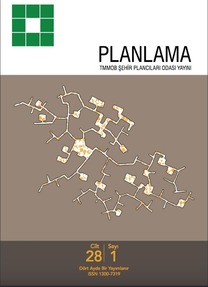Kadıköy Örneğinde Alternatif Tiyatro Sahnelerinin Kamusallık Bağlamında Kamusal Mekân ile Etkileşimi
The Impact of Alternative Theater Stages on Public Spaces within the Context of Publicness in Kadıköy
___
- Adut, A., (2012). A Theory of The Public Sphere. Sociological Theory, 30 (4), 238-262. DOI: 10.1177/0735275112467012
- Akbulut, R. (1992). Tanzimat’tan Cumhuriyet’e İstanbul ve Kadıköy Örneklerinde Plan Dinamikleri ve Mekânsal Dönüşüm İncelemesi. (Master Thesis). Mimar Sinan University, İstanbul.
- Akbulut, M. R. (1994). Kadıköy. İstanbul Ansiklopedisi. Cilt 4, 329-339.
- Arendt, H. (2013). İnsanlık Durumu. Bahadır Sina Şener (Çev.). İstanbul: İletişim.
- Atkinson, R. (2003). Domestication by Cappuccino or a Revenge on Urban Space? Control and Empowerment in the Manage- ment of Public Spaces. Urban Studies, 40 (9), 829–1843. DOI: 10.1080/0042098032000106627
- Banerjee, T. (2001). The Future of Public Space: Beyond Invented Streets and Reinvented Spaces. Journal of The American Planning Association, 67 (1), 9-24. DOI: 10.1080/01944360108976352
- Bengü, D. (2017). Kamusal Mekânın Yapılanmasında Kamusallık ve Ekin- sel Üretim Mekânlarının Rolü: Kadıköy Örneği. (PhD Thesis). Mimar Sinan Fine Arts Univesity, İstanbul.
- Ekdal, M. (2004). Kadıköy. İstanbul: KASDAV
- Erbaş, A. E. (2019). Cultural Heritage Conservation and Culture-Led Tour- ism Conflict Within the Historic Site in Beyoğlu, Istanbul. WIT Trans- actions on Ecology and the Environment, Vol 217, 647-659.
- Ercins, G. (2013). Demokrasinin Bir Önkoşulu Olarak Kamusal Alan ve Türkiye’de Kamusal Alan Algısı, C.Ü. İktisadi ve İdari Bilimler Dergisi, Cilt 14, Sayı 1, 297-313.
- Firidin Özgür E., Seçer S., Göğüş B., Sayın T. (2017). Use of public spaces in private space-led urbanization: The cases of Kadıköy and Ataşehir in Istanbul. ITU A|Z, 14 (1), 43-56, Istanbul.
- Firidin Özgür, E. (2019). Emerging Effects of Planned and Unplanned Devel- opments in Central Kadıköy, İstanbul. Gabrieli Rembarz (ed.) in Living in Harbour special issue Polska Akademia Nauk CLXXXVIII: 168-181. Warsaw
- Giz, A. (1998). Bir Zamanlar Kadıköy. İstanbul: İletişim
- Habermas, J. (2002). Kamusallığın Yapısal Dönüşümü. İstanbul: İletişim
- Hansen, M. (2010). Yirmi Yılın Ardından Negt ve Kluge’nin Kamusal Alan ve Tecrübe’si: Değişken Karışımlar ve Genişlemiş Alanlar. Meral Özbek (Ed.), in Kamusal Alan (p. 141-177). İstanbul: Hil.
- Kadıköy Theaters Platform. (2017). Benim Komşum Tiyatro, public an- nouncment, publishing date, 6 January 2017, http://www.kadikoytiya- trolari.com/benim-komsum-tiyatro/ Access date: 8 August 2017.
- Langstraat, F., Van Melik, R. (2013). Challenging the ‘End of Public Space’: A Comparative Analysis of Publicness in British and Dutch Urban Spaces. Journal of Urban Design, 18 (3), 429-448. DOI: 10.1080/13574809.2013.800451
- Linder, E. (2019). Three Phases of the Theatrical Public Sphere in Estonian Theatre. Nordic Theater Studies. Vol. 31, No. 1. 73-91
- Loukaitou-Sideris, A. (1993) Privatization of Public Space: The Los Ange- les Experience. Town Planning Review, 64 (2), 139-167. DOI: 10.3828/ tpr.64.2.6h26535771454436
- Lupu, A.G. (2016). The Reconfiguration of the Theatre Space and the Rela- tionship between Public and Private in the Case of Apartment Theatre, Romanian Journal of Communication and Public Relations vol. 18, no. 3 (39), 77-94
- Madanipour, A. (2010). Marginal public spaces in European cities, in Whose Public Space?, p:111-130. London: Routledge.
- Martin, A. M. (2010). Küçük Moda. İstanbul: Heyamola
- Mitchell, D. (2003). The Right to the City: Social Justice and the Fight fo ublic Space. London: The Guilford Press.
- Negt, O., Kluge, A. (1993). Public sphere and experience: Toward an analysis of the bourgeois and proletarian public sphere. Translated by P. Labanyi, J. O. Daniel, A. Oksiloff. Minneapolis: University of Minnesota Press.
- Negt, O., Kluge, A. (2010). Kamusal Alan ve Tecrübe’ye Giriş. Meral Özbek (Ed.), in Kamusal Alan (s. 133-140). İstanbul: Hil.
- Németh, J., Schmidt, S. (2011). The privatization of public space: modeling and measuring publicness. Environment and Planning B: Planning and Design, 38 (1), 5-23. DOI: 10.1068/b36057
- Öndeş, O. (2012). Modalı Vitol Ailesi. İstanbul: Tarihçi.
- Özbek, M. (Ed.) (2005). Kamusal Alan. İstanbul: Hil.
- Staniškytė, J (2018). Spectatorship, Politics and the Rules of Participation: Re-discovering the Audience in Contemporary Lithuanian Theatre. Nor- dic Theatre Studies Vol. 30, No. 2, 99–114
- Şeyler ve Şeytanlar, Bölüm 11: Yepyeni Tiyatro Örgütlenmeleri, broadcast date, 7 October 2016, Medyascopetv, http://medyascope.tv/2016/10/07/ seyler-seytanlar-10-yepyeni-tiyatro-orgutlenmeleri/ Access date: 8 Au- gust 2017.
- Timur, T. (2017). Habermas’ı Okumak. İstanbul: Yordam.
- Varna, G., Tiesdell, S. (2010). Assessing the Publicness of Public Space: The Star Model of Publicness. Journal of Urban Design, 15 (4), 575-598. DOI: 10.1080/13574809.2010.502350
- Yalçın, B. (2019). City as A Field of Cultural Production; The Case of Ka- diköy District in Istanbul (Unpublished Master Thesis), Graduate School of Social Science, METU, Ankara.
- Yükselbaba, Ü. (2008). Kamusal Alan Modelleri ve Bu Modellerin Bağlamları. İÜHFM C. LXVI, 2, 227-272. Interviews:
- Kemal Aydoğan, Moda Stage, personal interview, 10.11.2018
- Yurdaer Okur, Entropi Stage, personal interview, 8.11.2018
- Damla Kılıçoğlu, Karma Drama, personal interview, 4.03.2019
- Togay Kılıçoğlu, Karma Drama, personal interview, 4.03.2019
- Evren Duyal, İstanbulimpro, personal interview, 10.11.2018
- ISSN: 1300-7319
- Yayın Aralığı: Yılda 3 Sayı
- Başlangıç: 1986
- Yayıncı: TMMOB Şehir Plancıları Odası
Kadıköy Örneğinde Alternatif Tiyatro Sahnelerinin Kamusallık Bağlamında Kamusal Mekân ile Etkileşimi
Ebru Firidin Özgür, Devran Bengü
The Effect of Changes in Coastal Law on Land Use Change in Coastal Settlements: Kuşadası Center Case
Neriman Yörür, Ayşegül Altınörs Çırak, Sibel Ecemiş Kılıç, Rana Başak Serim, Neslihan Karataş
Türkiye’nin Otopark Politikasında Paradigma Değişimi İçin İki Öneri
Emine Yetişkul Şenbil, Metin Şenbil
Kentsel Güvenliğin Sağlanmasında Tasarım Rehberleri
Nilgün Çolpan Erkan, Tuba Koca
Yok Olan Spor Yapılarının Ardından Kentte Yıkma Eylemi ve Bellek: Trabzon Örneği
Şengül Yalçınkaya, Ümran Sofuoğlu
Julia Kristeva’da Platonik Mekân Kavramı “Chora”
Kentsel Mekanın Değişimi ve Gelişme Döngüleri; Eski Keresteciler Çarşısı (İzmir) Örneği
Neslihan Karataş, Mehmet Ali Kaya
Direnişçi Planlama: Gelişmekte Olan Ülkeler İçin Yeni Bir Planlama Kuramı
